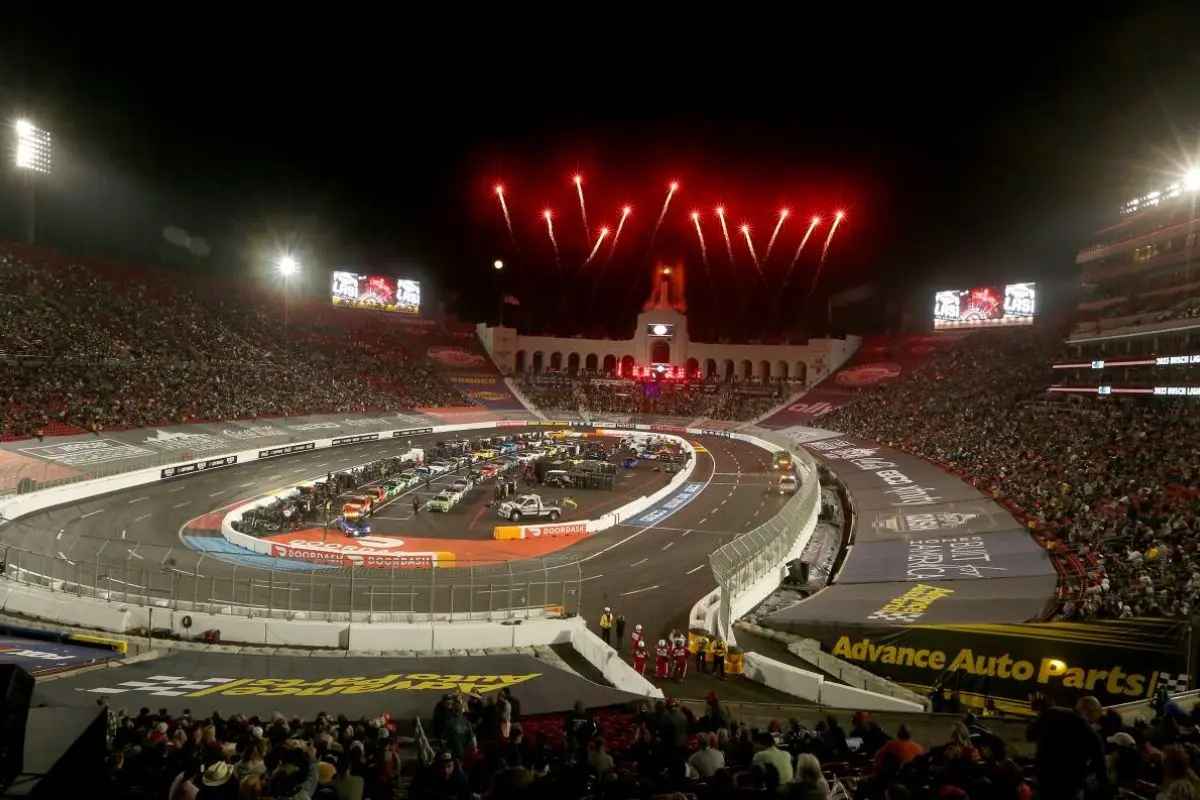NASCAR Shifts Back to Authentic Racing: NASCAR’s decision to return to Bowman Gray Stadium for the Clash highlights a tactical pivot toward its grassroots authenticity. This move is a response to criticism of urban spectacles like the Chicago Street Race, aiming to reconnect with its core fanbase. Known as “The Madhouse,” Bowman Gray is representative of NASCAR’s soul, offering a raw, demanding racing environment that contrasts sharply with modern venues.
Key Highlights
- NASCAR’s return to Bowman Gray Stadium highlights a shift towards grassroots racing and tradition.
- Hosting the Clash at Bowman Gray emphasizes NASCAR’s commitment to reconnecting with its core fanbase.
- Bowman Gray’s historical significance as a quarter-mile oval symbolizes racing’s authentic and raw experience.
- Tim Brown’s journey from mechanic to driver reflects NASCAR’s focus on perseverance and passion.
- The event signifies NASCAR’s strategic pivot towards balancing innovation with foundational racing allure.
NASCAR’s Shift Toward Grassroots Racing
In a notable nod to its origins, NASCAR’s recent pivot back to grassroots racing marks a tactical recalibration that balances modern innovation with the sport’s foundational allure.
In an era characterized by an aggressive push towards digital engagement and urban spectacle—highlighted by ventures like the Chicago Street Race and the LA Coliseum Clash—NASCAR has faced criticism for straying from its roots.
Yet, the pendulum now swings back towards tradition, reflecting a subtle strategy that seeks to harmonize cutting-edge advancements with the authenticity that initially captivated fans. This strategic shift is not just a nostalgic gesture but a calculated move to reintegrate the essence of stock car racing into its contemporary narrative.
The decision to return the Clash to Bowman Gray Stadium is a confirmation of this intent. Known as NASCAR’s longest-running weekly track, Bowman Gray holds a unique place in the sport’s history.
This venue embodies the raw, unfiltered spirit of racing—where community ties and local rivalries fuel the excitement, offering a clear contrast to the cosmopolitan glitz of recent events.
Bowman Gray Stadium: NASCAR’s Historic Core
How has Bowman Gray Stadium, a seemingly modest quarter-mile oval in Winston-Salem, come to represent the soul of NASCAR? The answer lies in its rich history and its embodiment of racing authenticity. Known affectionately as the “Madhouse,” Bowman Gray has been a crucible for short-track racing since 1949, fostering a raw, visceral form of competition that has captivated generations of fans and drivers similarly.
It stands as a testament to NASCAR’s roots, offering a thrilling, unadulterated racing experience that modern venues often lack. Bowman Gray’s appeal transcends its physical dimensions; it is a cultural icon within the racing community. The track’s tight quarters and unforgiving turns demand skill and bravery, evocative of NASCAR’s formative years when grit was a prerequisite and finesse was honed on the fly.
This return to the basics of motorsport is a tactical move by NASCAR to reconnect with its foundational fanbase, who have grown weary of the polished, entertainment-heavy spectacles that have dominated recent years.
Tim Brown’s NASCAR Dream and Journey
Tim Brown’s expedition to NASCAR’s premier stage is a tribute to perseverance and passion, weaving a tale that resonates deeply with the grassroots ethos of racing. For years, Brown balanced his dreams with the practical demands of life, excelling as a suspension and drivetrain specialist at Rick Ware Racing (RWR). His specialized expertise was not just a job; it was groundwork for his aspirations—an integral part of his path from mechanic to racing at the Clash in RWR’s No. 15 Ford. Brown’s story is a modern-day Cinderella narrative, rekindling the essence of racing’s humble beginnings.
“I’m good with working on race cars for a living because it’s still a pretty cool gig, but I always wanted to drive for a living.”
Brown’s legacy at Bowman Gray Stadium, affectionately dubbed the “Madhouse,” is nothing short of legendary. Holding an exceptional track record, he boasts 12 Modified titles, 101 feature wins, and the all-time fastest lap record. This success at Bowman Gray highlights his deep connection with the track and its fervent fans. Yet, his ascent to NASCAR’s elite circle is unconventional, marked by a unique blend of skill, tenacity, and an unyielding love for the sport.
Brown’s shift from Bowman Gray to the national stage symbolizes NASCAR’s resurgence to authentic racing. His path serves as a guiding light of hope and inspiration, proving that dedication and passion remain the heart of motorsport dreams.
Tim Brown: The Mechanic Who Never Gave Up
A tribute to resilience and steadfast resolve, Tim Brown embodies the spirit of a mechanic who refused to surrender his racing aspirations. At 53, Brown continues to chase a dream that many would have abandoned. His expedition emphasizes a profound connection to NASCAR, transcending beyond the driver’s seat to the very heart of a sport defined by grit and passion.
“I’m good with working on race cars for a living because it’s still a pretty cool gig, but I always wanted to drive for a living.” – Tim Brown
Brown’s path is representative of the blue-collar ethos that forms NASCAR’s foundation. Despite not reaching the pinnacle of driving fame, he finds fulfillment in a career spent crafting the very machines that race fans revere. His contributions have been crucial, working on cars for legends such as Cale Yarborough and Jack Roush. This extensive experience has shaped his unique perspective on the sport and honed his mechanical expertise.
Currently serving as a full-time mechanic for Rick Ware Racing (RWR), Brown’s story takes a remarkable turn as he prepares to drive the car he helped build. This opportunity is a reflection of the enduring allure of alternate chances and the power of persistence. For Brown, the chance to compete in a Cup race is more than a professional milestone; it is a personal victory.
“For Rick Ware and everybody involved here at RWR to give me the chance to go run a Cup race is so humbling and so heartwarming.” – Tim Brown
- Lifelong Dedication: Brown has dedicated his life to racing, working tirelessly to become a Cup driver.
- Behind-the-Scenes Impact: His mechanical skills have supported the careers of NASCAR icons.
- Unwavering Passion: Brown’s upcoming race embodies his relentless pursuit of a lifelong dream.
The Bowman Gray Clash and NASCAR’s Future
The spirit of perseverance embodied by Tim Brown finds a fitting arena at the Bowman Gray Clash, a race that could very well signal a new era for NASCAR. This event marks a return to the sport’s foundational elements—intimate, short-track racing that resonates with its core fanbase.
Brown’s decision to participate in the Madhouse Classic, just a day before the main event, emphasizes a clever connection to the track’s unique challenges, especially post-upgrades. The newly installed SAFER barriers, while enhancing safety, have altered the racing line slightly, adding another layer of complexity to Bowman Gray’s historic layout.
The guys who race these Cup cars today are elite.”
“They’re the best drivers in the world, and I’m not even going to put myself in that same category. I just want to climb out of that thing at the end of the Clash and see my son and our family with big smiles on their faces.” – Tim Brown
Brown’s realistic acknowledgment of his status in the NASCAR hierarchy—competing against elite Cup drivers—highlights a rejuvenating humility. Yet, it is this very humility that accentuates a broader narrative: NASCAR’s potential path forward lies not in extravagant urban venues but in embracing the grassroots essence that once defined it.
Rick Ware Racing’s choice to empower a local hero reflects a bold, tactical move amidst a landscape dominated by polished corporate entities. This decision rekindles a sense of authenticity, emphasizing NASCAR’s roots in community and local culture.
As Brown steps into the limelight, NASCAR is presented with an invaluable opportunity: to reconcile its storied past with its future ambitions. Bowman Gray isn’t merely a venue for a race; it’s a crucible for NASCAR’s revival, where the sport’s essence is authentically celebrated and renewed.
News in Brief: NASCAR Shifts Back to Authentic Racing
The return of NASCAR to Bowman Gray Stadium signifies a crucial shift towards grassroots racing, embodying a commitment to authenticity and historical roots. This move not only honors the sport’s rich heritage but also reinvigorates its connection with dedicated local communities. Tim Brown’s relentless pursuit of his NASCAR dream highlights the enduring spirit of resolve and passion that defines the racing community. The Bowman Gray Clash heralds a promising future for NASCAR, accentuating tradition while fostering innovation and engagement.
ALSO READ: Safety Updates at Bowman Gray Stadium Amid Fans’ Fear of Losing Tradition



